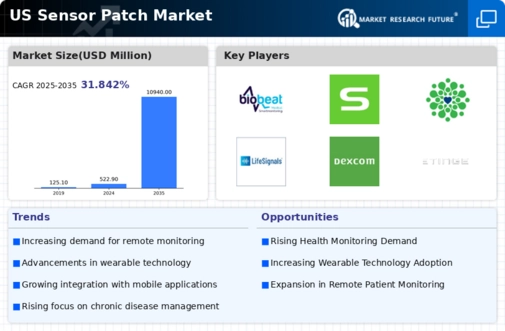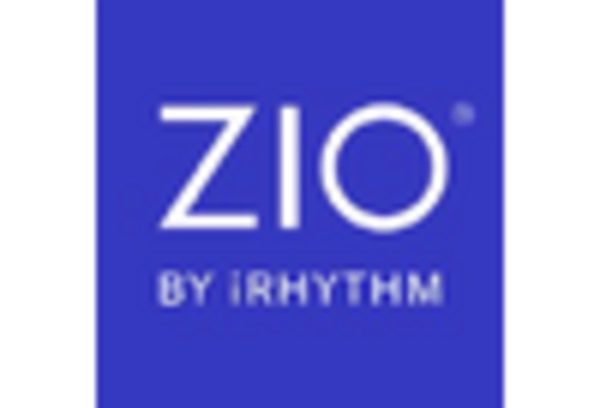Supportive Regulatory Environment
A supportive regulatory environment is emerging as a crucial driver for the sensor patch market. Regulatory bodies in the US are increasingly recognizing the importance of innovative health technologies and are streamlining approval processes for new medical devices. This trend is encouraging manufacturers to invest in the development of advanced sensor patches that comply with regulatory standards. The sensor patch market benefits from this environment, as it fosters innovation and accelerates the introduction of new products. Recent initiatives by the FDA to expedite the review of digital health technologies are indicative of this supportive stance. As regulations evolve to accommodate advancements in technology, the market is expected to witness accelerated growth, with more players entering the field and contributing to a diverse range of sensor patch offerings.
Rising Prevalence of Chronic Diseases
The increasing incidence of chronic diseases in the US is a pivotal driver for the sensor patch market. Conditions such as diabetes, cardiovascular diseases, and respiratory disorders necessitate continuous monitoring, which sensor patches can provide. According to recent data, chronic diseases affect nearly 60% of adults in the US, leading to a heightened demand for innovative health monitoring solutions. The sensor patch market is poised to benefit from this trend, as healthcare providers seek efficient ways to manage patient health remotely. The ability of sensor patches to deliver real-time data enhances patient outcomes and reduces hospital visits, thereby appealing to both patients and healthcare systems. This growing need for chronic disease management is likely to propel the sensor patch market forward, as stakeholders invest in advanced technologies to meet the demands of an aging population.
Technological Integration in Healthcare
The integration of advanced technologies into healthcare systems is significantly influencing the sensor patch market. Innovations such as artificial intelligence (AI), machine learning, and the Internet of Things (IoT) are enhancing the functionality of sensor patches. These technologies enable more accurate data collection and analysis, which is crucial for effective health monitoring. The sensor patch market is experiencing a surge in demand as healthcare providers adopt these technologies to improve patient care. For instance, AI algorithms can analyze data from sensor patches to predict health issues before they escalate, thus facilitating proactive healthcare. The market is projected to grow at a CAGR of approximately 15% over the next five years, driven by the increasing adoption of smart healthcare solutions that leverage these technological advancements.
Consumer Awareness and Health Consciousness
There is a notable increase in consumer awareness regarding health and wellness in the US, which is driving the sensor patch market. As individuals become more health-conscious, they seek tools that allow for better self-monitoring of their health metrics. This trend is reflected in the growing popularity of wearable health devices, including sensor patches, which provide users with real-time insights into their physiological conditions. The sensor patch market is likely to expand as consumers demand more personalized health solutions. Market Research Future indicates that approximately 70% of consumers are willing to invest in health monitoring technologies, suggesting a robust market potential. This heightened awareness is fostering a culture of preventive healthcare, further propelling the demand for sensor patches that facilitate continuous health tracking.
Increased Investment in Healthcare Technology
Investment in healthcare technology is on the rise, significantly impacting the sensor patch market. Venture capital and private equity firms are increasingly funding startups and established companies focused on developing innovative health monitoring solutions. This influx of capital is enabling the sensor patch market to expand rapidly, as companies can invest in research and development to enhance product offerings. Recent reports indicate that investment in digital health technologies has surged by over 30% in the past year, reflecting a strong belief in the potential of sensor patches to transform healthcare delivery. As funding continues to flow into this sector, the market is likely to see accelerated innovation and a broader range of applications for sensor patches, ultimately improving patient care and health outcomes.
















Leave a Comment